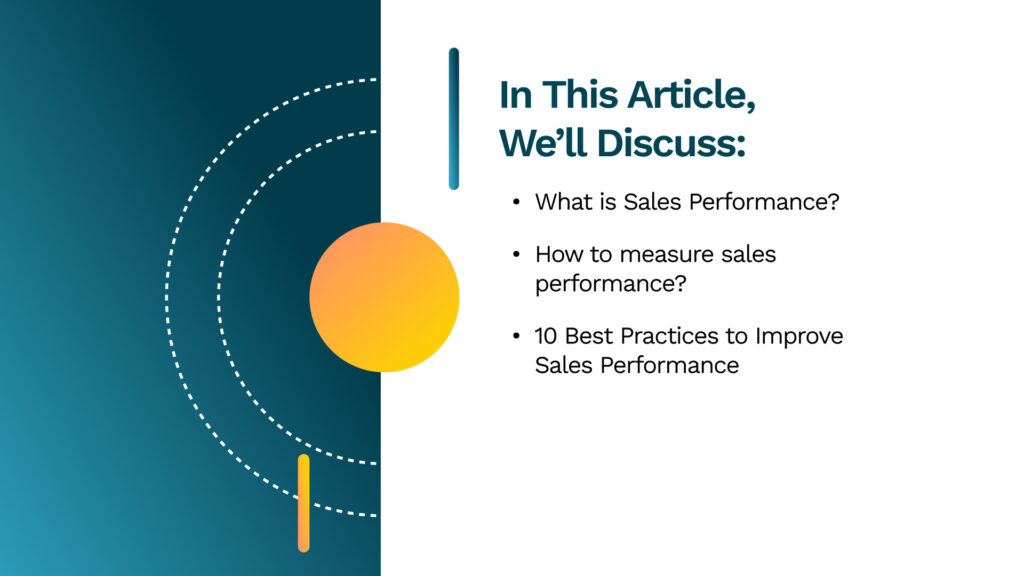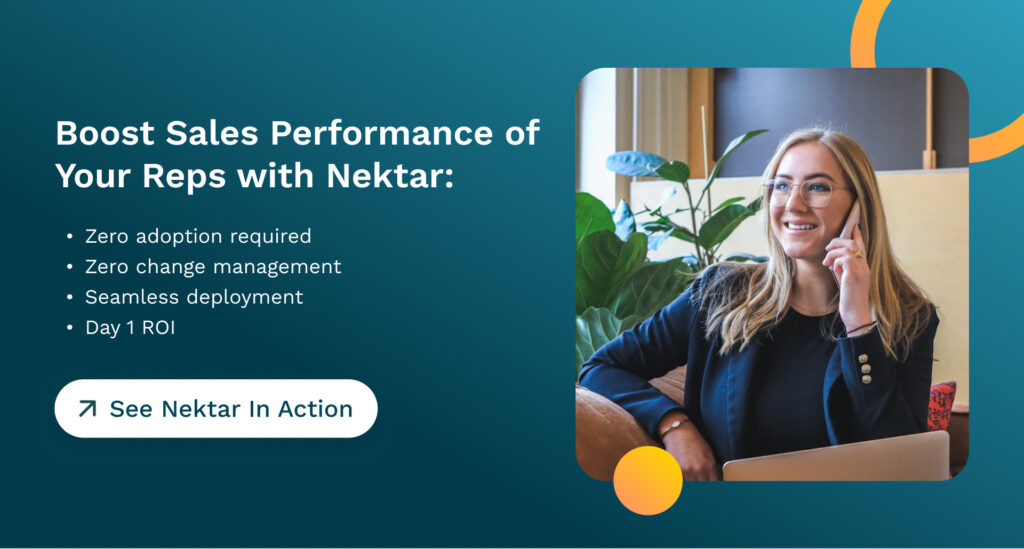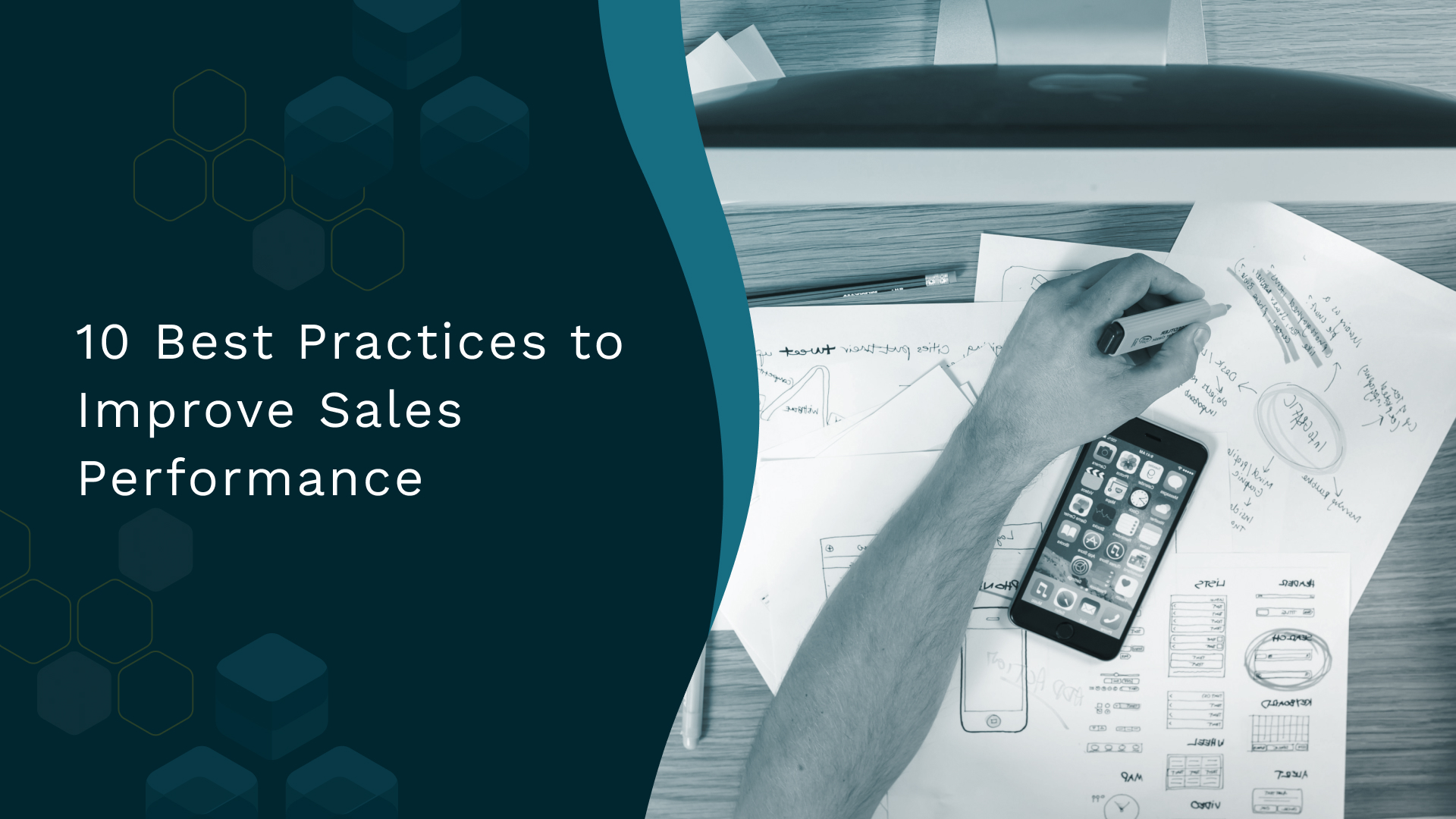Quarterly sales performance not looking good?
The reasons could be one or all of these.
- Not enough new opportunities.
- Not enough reps prospecting.
- Low win rate.
Numbers don’t lie.
But scratch below the surface and you might find the one thing really missing: clarity.
Clarity on how to achieve sales quotas, motivate your team and drive revenue.
What better way to build clarity than by asking the right questions?
You’ll know exactly how to improve sales performance.
Most problems relating to sales performance are interconnected.
Address one and you will have impacted the other.
All you need is a strategic, data-backed approach to measuring and managing sales performance.

What is Sales Performance?
Are your current sales activities bringing in the revenue you expected?
The answer to this question is the sum of your sales performance – actual results against target metrics. For example, close % achieved versus close % goal over a certain time period.
Analyzing sales performance can help you:
- Get to the root cause of people and process gaps and
- Help you learn how to improve sales performance in the best possible way
Sales performance issues arise mainly due to:
1. Process gaps
This can be due to ‘environmental’ factors – KPIs, sales process, team alignment, sales strategy, etc.
The right process can set your sales team up for success like nothing else.
2. People gaps
This has to do with sales effectiveness – motivation, low business acumen, poor time management, communication, etc.
Data quality is key to closing both these gaps.
It can tell you ‘why’ you may be behind on some goals and figure out ‘what’ you need to do to get there.

How Can You Measure Sales Performance?
Want to know how to improve sales performance?
You know the drill. Pull up the data.
Now, CRM or sales enablement tools track hundreds of different metrics.

How can you be sure what to look for?
For starters, let’s categorize sales metrics into:
1. Overall sales metrics
Total sales revenue, pipeline value, open opportunities, and the like.
2. Sales activity metrics
Meetings booked, meetings held, clients pitched, close ratio, etc. come under this category.
3. Pipeline metrics
These are metrics like the number of leads, win rate, average deal size, conversion rate, etc.
4. Lead generation metrics
MQLs, SQLs, conversion rate, etc. are some key lead generation metrics.

How to Identify the Best Metrics to Track?
Tracking every metric might be impractical. Instead, think of them as a pyramid.
Overall sales metrics give you the big picture.
So they are at the top of the pyramid. But it’s the other three categories that form the base.
- Measuring leading indicators can tell you which sales activities to focus on at any given time.
- Talk to sales reps. They can fill you in on the latest changes in customer preferences.
- Combine the two with buyer journey mapping, and you have the exact sales metrics you need to double down on.
How to Improve Sales Performance: 10 Best Practices
Team-level strategies for improving sales performance:
1. Standardize business metrics for increasing team buy-in
Like all industries, some sales metrics are clearly defined.
For example, total revenue. Others have multiple definitions across teams.
Case in point: inside sales might define ‘close rate’ as all leads that convert into meetings.
For AEs, it might be the percentage of proposals that convert into deals.
A consistent set of definitions can help each team better appreciate how their work impacts the sales ecosystem.
This can enable objective comparisons and drive greater collaboration.
2. Create an end-to-end workflow integration
This will create a single version of truth across sales and beyond.
The data generated can help sales reps clearly see the relationship between the activities they do.
Managers can optimize sales cadences to address specific goals.
Workflow integration can help in:
- Optimizing the sales process for the multi-channel B2B buyer journey. For example personalized sales cadences.
- Focusing on the deal stages that have the most friction
- Getting deep insights into buyer behavior across the sales funnel
- Identifying key decision makers and giving reps enough context in multithread scenarios
3. Align team structure for higher sales velocity
Restructuring the team structure can help you get the most out of workflow integration.
In the multi-channel sales environment of today, AEs need all the support they can get.
To increase win rates, consider:
a. Realigning sales and marketing:
Some good questions to ask might be:
- Are both teams on the same page regarding ICPs and target accounts?
- Do SPOCs sit in on each other’s review meetings for real-time feedback?
- Do they have a process for data standardization?
b. Realigning sales team structure
If your goal is high-velocity sales, consider setting up cross-functional teams.
This approach can collapse department silos like nothing else.
For example, the POD structure aligns inside sales, AE, and CS reps into one unit, driving customer acquisition and retention.
This can be crucial at a time when sales cycles are slowing down and ACV is declining across industries.
Don’t have enough people?
Adapt your team structure for sales season or specific events like a new product launch.
You can even cross-skill experienced reps to handle both sales and renewals depending on the industry you’re in.
4. Review your sales motion
B2B buyers are demanding self-service more than ever.
But sales reps still have a key role to play in facilitating sales.
The key is having an ‘assisted’ sales motion for every buyer persona and use case.
An effective assisted sales motion:
- Prioritizes customer needs over rules and procedures (reps are allowed to skip the sales script as needed)
- Uses data analytics to identify the buying tasks people are having trouble with.
- Provides timely content designed to make buying easy.
- Maps buyer activity to specific CRM accounts
- Uses feedback forms and surveys to iterate sales tactics over time
5. Prioritize ease of purchase
Let’s face it.
Sales processes make life easier for sales reps.
At the expense of buyers. 77% of B2B buyers say their last purchase was complicated.
To increase the odds of conversion:
- Use buyer enablement to create personalized content for each buyer persona. For example, checklists, case studies, FAQs, etc.
- Add expanded search functionality for products across categories. This can reduce cart abandonment to a large extent.
- Integrate AI-powered chatbots that can provide contextual recommendations and support.
Rep-level strategies for improving sales performance:
6. Double down on coaching and feedback
It takes 3.2 months for new hires to be productive.
This is a huge drain on sales performance in terms of lost revenue.
Sales managers can address this by:
- Assigning late-stage opportunities for new hires to close. This can improve ramp-up time and boost team performance
- Supplementing 1:1 coaching with shadowing sessions for slow performers
- Encouraging best practice sharing at team meetings and focus groups

7. Make sales goals look achievable
No doubt yearly sales goals have to be challenging.
But they can seem too big for sales reps that didn’t make quota last year.
The solution:
- Break them down into quarterly and monthly goals.
- Explain why the goals are important from a business perspective
- Share reporting data on a daily basis. This will help sales reps focus better
8. Use UX principles for sales enablement
What use is sales enablement content if reps can’t find it at the right time? This directly impacts sales productivity.
To increase selling time, sales enablement teams can focus on:
- Automating data capture and after-call work
- Organizing sales scripts, product FAQs, and other resources into a single database
- Integrating CRM with learning tools allows instant access
9. Champion employee experience
The high employee turnover rate says it all.
B2B sales is tough.
More so if your team works remotely.
The best way to retain top talent and protect revenue is to:
- Have an online/offline feedback mechanism for employees to share their concerns
- Reframe sales performance goals from an employee-centric perspective. Connect performance milestones to incentives.
- Avoid micromanaging. Instead, give guidance and support when needed.
10. Build a high-performance culture
A high-performance culture fosters competition and accountability.
Without it, sales teams may lose focus and settle into a comfort zone.
- Run contests to motivate reps, especially during lean times.
- Discuss individual sales performance openly in team meetings. This promotes learning and healthy competition.
- Create a sales leaderboard for the top performers
Missing Data Can Kill Sales Productivity. So..
As business goals change, sales teams must adapt too.
Investing in the latest sales tech is important.
But without solid data governance, the business impact could be minimal.
The key is to integrate sales activity data from CRM and sales tools.
In fact, why burden sales reps with the task of capturing sales data at all?
Nektar.ai is a sales data aggregator tool that multiplies sales productivity by:
- Capturing contact and activity data and syncing it to CRM
- Mapping buyer activity across tools to specific accounts
- Enabling strategic insights by pushing enriched data to your BI tool
Want to know what data you might be missing? Talk to us.







